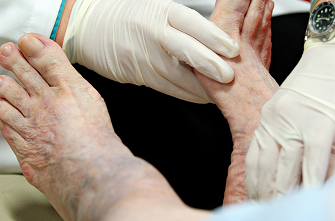
Your feet are supplied with blood to keep them healthy. They also have a multitude of nerves that act as an emergency warning system. For example, if you have a stone in your shoe, nerves will send a message to your brain to investigate. However, if your diabetes is poorly controlled for a long period of time, this may lead to:
- Nerve damage, or “peripheral neuropathy”, which impairs sensation to the feet.
- Reduced blood supply, also known as “poor circulation”.

Nerve damage may mean that you no longer notice the stone in your shoe, due to loss of sensation to your feet. This could then lead to an injury you can’t feel, and possibly infection.
If you have poor circulation, any injuries or infections to your feet (i.e. cuts, burns or scratches) will take longer to heal. This is due to less blood flowing into the arteries in your feet. Blood provides energy to working muscles and aids in healing any tissue damage. If you have poor circulation, you will need to take extra care to protect your feet from injury. Most foot problems in people who have diabetes occur when injuries and often infections go unnoticed and untreated, or when healing is delayed due to poor circulation.
A six or twelve monthly foot assessment by your podiatrist will help to detect any changes early before they become a problem. In a diabetes assessment your podiatrist will examine your circulation. They will examine sensation by testing reflexes, vibration and pressure sensitivity. Your podiatrist will also look for general foot conditions that may lead to future problems. They will work with you to show you how to monitor your own feet, in between consultations.
